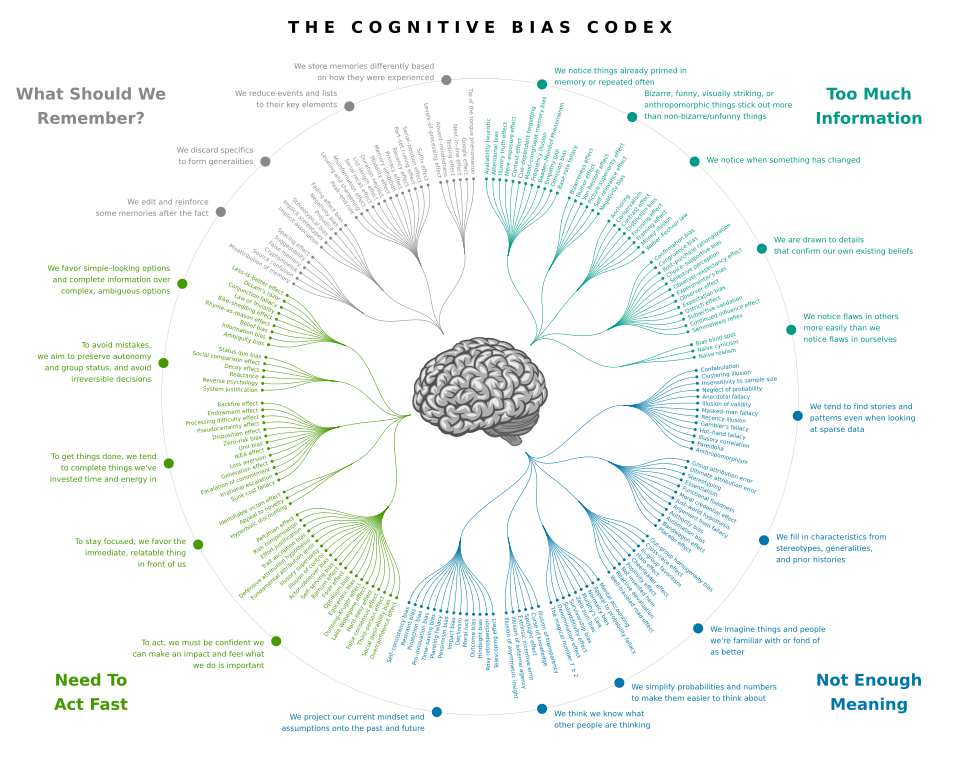Cognitive biases
Shortcuts from data acceptance to passed-on information
Cognitive biases are shortcuts in thinking that a person has found successful in the past and which they lean into going forward. We need them. They started as a survival tool, and helps us efficiently get through our days.
Remember Chutes and Ladders, the children’s board game? A cognitive bias acts like a chute, getting you that much further down the board without having to go through the thinking that would be involved if you had to start from scratch. It’s tempting to write, “with all the data,” but that itself is a cognitive bias (information bias — one that I leverage frequently).
The concept of cognitive biases is relatively recent in our cultural lexicon. New patterns are being added regularly. I mostly agree with broad categories that Buster Benson organized them in as John Manoogian III designed into the Cognitive Bias Codex, and it’s definitely a useful jumping-off point:
What should we remember?
aka what information to keep in closest possible proximity
Too much information
aka what new information will I pay attention to
Not enough meaning
aka how to make a decision with the available information, which is more sparse than reasonable for the decision at hand
Need to act fast
aka respond to the decision at hand with the urgency it demands
They gravitate towards in-the-snap processing chain — the information to look for/see/consider (aka perception), how to deal with the density, what memory to leverage and how, and all with the intent of taking a step forward.
While they gravitate to use in a moment, cognitive biases are everywhere and everywhen. They can affect that next step you take or the dissertation you spent 4 years writing. Unmonitored, they are one of the things that define the fate of your life. Monitoring them is one of the easier ways to wrest agency back into your life…and it’s still not easy.
The more a person uses a cognitive bias, the more likely they will again; if a decision lead to an expected/wished outcome, the buy-in will be heightened.
We can, and should, question cognitive biases. Again, it’s not easy; they are easier to crack when urgency is diminished. The more they are used, in the greater breadth of circumstances, the more likely a person is to reach for it again.
Cognitive biases are pervasively leveraged by others. They compromise a huge part of financial and social bets. Cognitive biases are second only to emotional narrative in marketing tools. A few big ones are the central pivot points of most UX design, and they are the cornerstone to gamification: availability bias, automation bias, attentional bias, loss aversion.
More than that, every system set up to promote efficiency and speed is, ultimately, predicated on cognitive biases. That means that when you are running through the process for picking up a rental car at the airport, you are fed into the stream of trained cognitive biases. Same with paying your cable bill, or when you go to the doctor for help getting rid of an infection.
Every system built to minimizing known risk and efficiently move a person through it leverages cognitive bias.
meaning, memory, ouruborus
Grant, A. (2023). Think again: The power of knowing what you don’t know. Penguin.
Kahneman, D. (2012). Thinking, Fast and Slow. Penguin Books.
Novella, S. (2012). Your Deceptive Mind: A Scientific Guide to Critical Thinking Skills. Teaching Company.
Thomas, D. D. (2020). Design for cognitive bias. David Thomas.
...Cognitive Bias Codex...
By design: John Manoogian III categories and descriptions: Buster Benson implementation: TilmannR - This file was derived from: The Cognitive Bias Codex - 180+ biases, designed by John Manoogian III (jm3).png:, CC BY-SA 4.0, https://commons.wikimedia.org/w/index.php?curid=69756809
